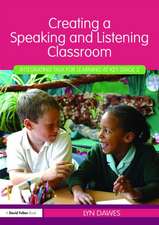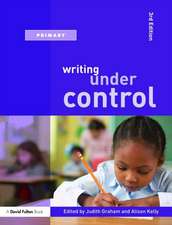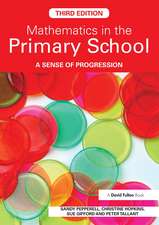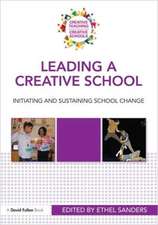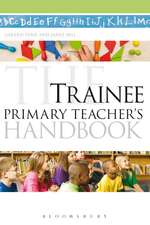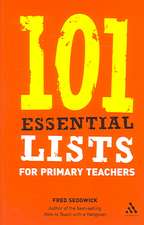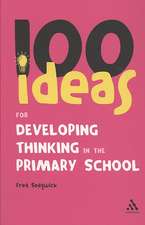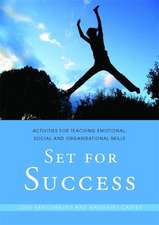Teaching Foreign Languages in the Primary School
Autor Dr Claudine Kirschen Limba Engleză Paperback – 14 iun 2008
Preț: 307.41 lei
Preț vechi: 334.28 lei
-8% Nou
Puncte Express: 461
Preț estimativ în valută:
58.83€ • 63.88$ • 49.42£
58.83€ • 63.88$ • 49.42£
Carte tipărită la comandă
Livrare economică 22 aprilie-06 mai
Preluare comenzi: 021 569.72.76
Specificații
ISBN-13: 9780826489494
ISBN-10: 0826489494
Pagini: 240
Ilustrații: Illustrations
Dimensiuni: 189 x 246 x 13 mm
Greutate: 0.48 kg
Editura: Bloomsbury Publishing
Colecția Continuum
Locul publicării:London, United Kingdom
ISBN-10: 0826489494
Pagini: 240
Ilustrații: Illustrations
Dimensiuni: 189 x 246 x 13 mm
Greutate: 0.48 kg
Editura: Bloomsbury Publishing
Colecția Continuum
Locul publicării:London, United Kingdom
Caracteristici
This textbook provides a structured framework for language teaching at primary level that is both highly effective and immediately enjoyable.
Cuprins
1. Teaching foreign languages in the primary school: an overview2. Case studies of two successful schools3. Theories of Second Language Acquisition4. Approaches to language teaching5. What children say about learning foreign languages6. Introducing children to foreign languages7. Developing children's listening and speaking skills8. Developing children's reading and writing skills9. Developing knowledge about language10. Developing intercultural competence11. Developing language learning strategies12. Assessment and transition to secondary school
Recenzii
"This book fills a significant gap in the literature on early language learning and will appeal to all those with an interest in the field, including practitioners, trainee teachers, advisers and postgraduate research students. It paints a picture of early language learning on a broad canvas, drawing on research data from secondary sources as well as from the author's own studies. The practical focus of the book is underpinned by a sound understanding of the theories behind second language acquisition and pedagogy, and it is this combination which renders it invaluable, and fascinating, reading." - Dr. Amanda Barton, University of Manchester, UK
Mention -Book News, November 2008
In her review of this proposal Dr Amanda Barton noted the following selling points: 1) The theoretical background chapters will make useful reading, especially for students on ITT courses 2) Cross-curricular links 3) Chapter 11 on continuity with secondary school is a very welcome addition that has barely been addressed in similar books 4) Excellent to have links to the KS2 Framework underlined for teachers, with whole sections on 'Knowledge about Language' and 'Cultural Understanding' Dr Amanda Barton, Lecturer in Education, Subject Leader PGCE MFL, University of Manchester
'This book is based on a sound view of language learning...[and] reflects the latest implications from research in cognitive linguistics, sociolinguistics and functional linguistics...The author has rich experience of teaching MFL in primary schools and training MFL teachers...In my view the 'cross-curricular links' and 'activities' will be particularly appealing to classroom teachers.' Xiaotang Cheng, Beijing Normal University
"Over two thirds of the book focuses on practice rather than principles. This shows that the author is well informed of the needs of primary school teachers, as well as new teachers...The case studies will be very attractive to readers." - Weicheng Zou, Foreign Lanuguages School, East China Normal University
Teaching Foreign Languages in the Primary School is designed as a resource for training and practising Modern Foreign Languages (herein language) teachers. The book manages to cover a lot of territory, combining the research literature, case studies and the author's own experience as a classroom teacher to produce a text which should be highly accessible and appealing to this audience. It also manages to strike an appropriate balance between theory and practice: it introduces the key theories and traditions and encourages teachers to reflect on how theory and beliefs about Second Language Acquisition and pedagogy may inform their own practices. At the same time it provides plenty of practical ideas and examples for them to use in their own classrooms.
Mention -Book News, November 2008
In her review of this proposal Dr Amanda Barton noted the following selling points: 1) The theoretical background chapters will make useful reading, especially for students on ITT courses 2) Cross-curricular links 3) Chapter 11 on continuity with secondary school is a very welcome addition that has barely been addressed in similar books 4) Excellent to have links to the KS2 Framework underlined for teachers, with whole sections on 'Knowledge about Language' and 'Cultural Understanding' Dr Amanda Barton, Lecturer in Education, Subject Leader PGCE MFL, University of Manchester
'This book is based on a sound view of language learning...[and] reflects the latest implications from research in cognitive linguistics, sociolinguistics and functional linguistics...The author has rich experience of teaching MFL in primary schools and training MFL teachers...In my view the 'cross-curricular links' and 'activities' will be particularly appealing to classroom teachers.' Xiaotang Cheng, Beijing Normal University
"Over two thirds of the book focuses on practice rather than principles. This shows that the author is well informed of the needs of primary school teachers, as well as new teachers...The case studies will be very attractive to readers." - Weicheng Zou, Foreign Lanuguages School, East China Normal University
Teaching Foreign Languages in the Primary School is designed as a resource for training and practising Modern Foreign Languages (herein language) teachers. The book manages to cover a lot of territory, combining the research literature, case studies and the author's own experience as a classroom teacher to produce a text which should be highly accessible and appealing to this audience. It also manages to strike an appropriate balance between theory and practice: it introduces the key theories and traditions and encourages teachers to reflect on how theory and beliefs about Second Language Acquisition and pedagogy may inform their own practices. At the same time it provides plenty of practical ideas and examples for them to use in their own classrooms.

